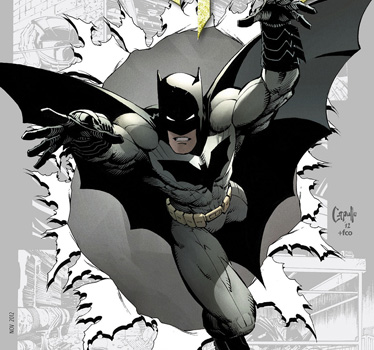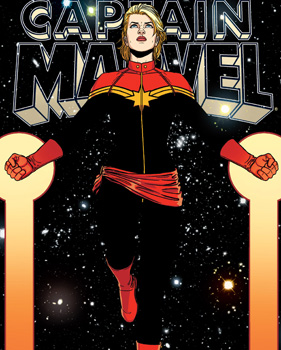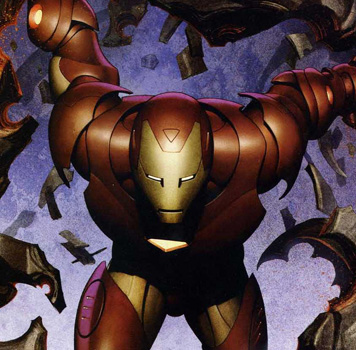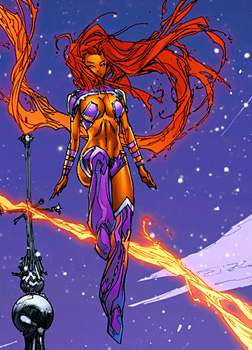Mainstream comics have traditionally featured superheroes or, more recently, anti-heroes. Whether it’s Batman, Starfire, Captain Marvel, or Iron Man, the characters that inhabit most of the comics published by the Big Two – and, to a certain degree, smaller publishers as well – feature someone (or a team of someones) who beats up the bad guys to protect the innocent. What drives someone to put on a costume and use his or her powers for good, though?
I’ve looked at more than a few origin stories for heroes. By and large, they have a lot of the same factors: they suffer a trauma, they react to that trauma, and they begin their life as a hero. I’m going to take a look at a handful of heroes and anti-heroes from the Big Two to investigate these things, and then I want to ask the big question: is there another way for a superhero to develop?
Batman
Bruce Wayne has been Batman for years upon years, and decided to become a hero long before that.

The trauma: When Bruce was eight years old, he and his parents went out for a nice night on the town. They were mugged on their way out of the theatre they went to, and both Thomas and Martha Wayne died in front of little Bruce.
The reaction: The common belief is that Bruce swore pretty soon after his parents’ deaths that he would someday stop crime in Gotham. It’s easy to believe that of the man behind the mask; Bruce seems utterly devoted to justice. There’s a curious little Batman Black-and-White story, found in Gotham Knights #20, that solidifies the idea that Bruce became Batman in his head long before he ever put on the cape and cowl. Bruce left home at an early age to train with masters of different skills from around the world, and when he returned home, he donned his Bat-ears and started his life of fighting crime. Batman: Year One gives an excellent look at this particular bit of Bruce’s career.
The legacy: Batman is one of the best-known superheroes to date. The Batman franchise is the seventh-highest grossing franchise of all time; two of the three movies in Christopher Nolan’s recent trilogy are in the top twenty highest-grossing films of all time. Six Flags entertainment parks nationwide, which are affiliated with Warner Bros. (which owns DC), have attractions dedicated to the Dark Knight. Several cartoons have featured Batman over the years, including Batman: The Animated Series, which won four Emmys. Batman is part of our popular culture, and chances are good that he’ll stick around for a good while.
Captain Marvel
Carol Danvers is ex-Air Force, ex-Homeland Security, and ex-several other identities. She’s currently rocking as Captain Marvel.

The trauma: Carol was working as the head of security at NASA along with the original Captain Marvel, a Kree hero named Mar-Vell. In typical 60s fashion, he saved her life during an accident at work and she fell in love with him… which made her a target for a Kree villain with a serious hatred for Mar-Vell. The villain kidnaps Carol and, in the course of the fight to save her again, deploys a machine called the Psyche-Magnitron, which basically grants the wish of anyone who uses it. The machine explodes during the fight, and Carol’s wish to be an equal of Captain Marvel’s combined with the fact that Mar-Vell shielded Carol against the blast with his body gave Carol her powers.
The reaction: Carol became known as Ms. Marvel when she got her own book in the 1970s (most of which has been reprinted in the Essential Ms. Marvel book). She has suffered trauma after trauma since: she’s been exiled to Limbo, raped and forced to bear a child, depowered, and has suffered from alcoholism. Carol has come back from each of these things stronger than before, and she’s now taken over the name of Captain Marvel to honor Mar-Vell.
The legacy: Carol Danvers is a striking character because of just how much she’s been through. Her origin is traumatic in its own right: she falls for a guy, and is then used as a pawn so the guy’s enemy can kill him; not only that, but during her rescue, she gains superpowers that at first she doesn’t even remember having. Since Carol was created in the 60s, she’s suffered through a lot of really horrifying things, some of which have been handled delicately, and some of which have not. The character today is a culmination of everything that has happened to her, and the current ongoing Captain Marvel is a book that acknowledges what Carol has gone through and continues to push her to greater and greater heights.
Iron Man
Tony Stark is everyone’s favorite genius billionaire playboy philanthropist! Well, mostly everyone. Probably not Justin Hammer.

The trauma: Tony was a civilian living the high life when he was captured and tortured by enemies of the USA. (The initial origin in Tales of Suspense #39 had him captured by the Vietnamese; a more recent origin told in the Extremis arc takes place in Afghanistan. Choose your retcon!) He ends up with shrapnel in his chest, and has to have a giant magnet in his chest to keep it from killing him. In order to escape, he builds the first Iron Man suit so he can break out and make his way home, intent upon altering his practices in order to change his impact on the world.
The reaction: When Tony got back home, he didn’t just settle back into his life – he kept up his role as Iron Man as well. For a while, he didn’t reveal his identity for various reasons (he didn’t want the extra attention, he just wanted to remain anonymous, he didn’t want to worry people, etc.). There was a period where everyone thought that Iron Man was Tony’s hired bodyguard. He became a founding member of the Avengers, and his identity eventually became public.
The legacy: With three Iron Man solo movies and Iron Man’s appearance in The Avenger, it’s fair to say that Tony Stark is in the public eye. All three of the solo movies are in the top hundred highest-grossing films of all time, and at the time this article was written, Iron Man 3 was in fifth place overall. It can definitely be argued that the Avengers film franchise is built on the success of Iron Man; if you take a look at the Marvel Cinematic Universe Timeline, you can see that they’ve labeled Tony’s “I am Iron Man” quote as the point of origin for the Avengers coming together. There’s no doubt that Iron Man is just as well-known in the public sphere today as Batman is, even though he’s been in the limelight for far less time.
Starfire
Koriand’r was born a princess on Tamaran. She has an intense amount of power, but is also one of the most compassionate heroes out there. Unless you hurt one of her friends, that is.

The trauma: Kory was born the second of three children. When she was young, her older sister Komand’r fell ill and was ultimately crippled, which made her unfit to rule. Succession fell to Kory, and a bitter Komand’r betrayed her planet to The Citadel, an enemy force trying to invade Tamaran, to get revenge. The king was forced to turn Kory over to The Citadel’s forces to ensure peace for Tamaran, and she spent years being tortured in captivity. (The story is told in its entirety in Tales of the New Teen Titans #4, reprinted in the Archive book listed below.)
The reaction: Kory gained her powers while in captivity: she and Komand’r were used as test subjects, as their captors wanted to see how much energy a Tamaranean could take before their bodies exploded. Komand’r’s forces attacked the facility before the experiment was completed, and Kory used her new powers to free herself and her sister – who promptly repaid her by knocking her out and capturing her for execution. Kory managed to escape with the help of the Teen Titans, and she fled to Earth and took up the name Starfire.
The legacy: Kory’s capacity for love and forgiveness can be seen in the little blurb I’ve given – she forgave Komand’r for pretty much being the reason she was tortured throughout her childhood, and did her best to help even when it would have been in her own best interests to let go. She was one of the main characters on the original Teen Titans cartoon, and is once again featured in the new Teen Titans Go! cartoon. Her role in both shows showed her as a compassionate character, a trait that came under fire with DC’s recent reboot. Kory – now Kori – was introduced as someone who wasn’t interested in relationships, didn’t much believe in compassion, and seemed not to care for clothing even when it probably would have helped. The switch to writer James Tynion IV (beginning with issue #19) has explained some of this away, bringing Kori more in line with the Kory of old, and showing that it’s possible to have someone recover from trauma and be affected by it without letting it bog them down.
So, is there another way for a superhero to develop? There are a lot of other heroes who have tragic back-stories. Nightwing and Red Hood were both orphaned young. Captain America was born so weak and sickly that he couldn’t join the Army. Green Lantern Hal Jordan witnessed his father’s plane crash. Wasp sought out her powers after her father was murdered. There are horrible things in the history of a lot of your favorite characters, whether it’s something they bring up on a day-to-day basis (like Bruce Wayne’s issues with his parents) or not (you rarely hear about the sexual assault that the Scarlet Witch suffered, but it’s in her history).
It is, however, possible to develop a character that becomes a hero without a traumatic past. Both Barry Allen and Wally West, the first and second Flashes, gained their powers through a combination of freak storms and weird chemicals. Wonder Woman originally came to the world of men on a mission of peace and diplomacy. All of the founding members of the Fantastic Four gained their powers because they were in the right place at the right time (or wrong time, depending on your views there). It could be argued that Superman’s origin includes a traumatic event – losing your entire planet and race in a single event certainly isn’t peaches and cream – but the thing that leads him to become a hero is his desire to do good in the world, not the pain of losing his birth parents and home planet.
So if it’s possible to create heroes without tragic back-stories, why is it such a prevalent practice? It’s an excellent question… and one that I’ll talk about next Friday. Tune in next week, same Bat time, same Bat channel, for the epic conclusion of What Makes a Hero!
It’s a good thing this isn’t required reading – there’s a lot this time! If you want to read any of the origin stories I mentioned in the article, check out the links below.
Batman: Year One. Written by Frank Miller; art by David Mazzucchelli. First published 1988; collects Detective Comics Vol. 1 #404-407. Find it on Amazon or buy it from comixology.
Captain Marvel: In Pursuit of Flight. Written by Kelly Sue DeConnick; art by Dexter Soy and Emma Rios. Published 2012; collects Captain Marvel Vol. 5 #1-6. Find it on Amazon or buy it from comixology.
Essential Ms. Marvel. Written by Gerry Conway, Chris Claremont, Archie Goodwin, and Jim Shooter; art by John Buscema, Keith Pollard, Jim Mooney, and Sal Buscema. Published 2007; collects Ms. Marvel #1-23 and Marvel Super-Heroes Magazine #10-11.. Find it on Amazon or buy it from comixology.
Gotham Knights #20. Written by Devin Grayson with backup by Julius Schwartz and Dan Raspier; art by Roger Robinson with backup by Christian Alamy. Published 2001. Buy it from comixology.
Invincible Iron Man, Vol. 1. Written by Stan Lee and Larry Lieber; art by Don Heck and Jack Kirby. Published 2010; collects Tales of Suspense #39-50. Find it on Amazon or buy it from comixology.
Iron Man: Extremis. Written by Warren Ellis; art by Adi Granov. Published 2005; collects Iron Man #1-6. Find it on Amazon or buy it from comixology.
Red Hood and the Outlaws: The Starfire. Written by Scott Lobdell; art by Kenneth Rocafort. To be published July 2013; collects Red Hood and the Outlaws #8-14. Find it on Amazon or buy it from comixology.
The New Teen Titans Archives, Vol. 3. Written by Marv Wolfman; art by George Perez. Published 2006; collects The New Teen Titans #17-20 and Tales of the New Teen Titans #1-4. Find it on Amazon.
Comments? Questions? Want to tell me about another hero who fits the pattern – or one who doesn’t? Leave a reply! I’ll be happy to talk comics with you.

Pretty great look at how trauma can lead to heroes. It leads to villains all-too-often in comics. I’m really looking forward to part two. It’s also inspired me to do a response piece, hopefully within the next month.
[…] What Makes a Hero? […]